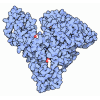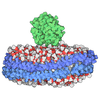[English] 日本語
 Yorodumi
Yorodumi- PDB-1fnf: FRAGMENT OF HUMAN FIBRONECTIN ENCOMPASSING TYPE-III REPEATS 7 THR... -
+ Open data
Open data
- Basic information
Basic information
| Entry | Database: PDB / ID: 1fnf | ||||||
|---|---|---|---|---|---|---|---|
| Title | FRAGMENT OF HUMAN FIBRONECTIN ENCOMPASSING TYPE-III REPEATS 7 THROUGH 10 | ||||||
 Components Components | FIBRONECTIN | ||||||
 Keywords Keywords | CELL ADHESION PROTEIN / RGD / EXTRACELLULAR MATRIX | ||||||
| Function / homology |  Function and homology information Function and homology informationnegative regulation of monocyte activation / negative regulation of transforming growth factor beta production / Extracellular matrix organization / positive regulation of substrate-dependent cell migration, cell attachment to substrate / calcium-independent cell-matrix adhesion / Fibronectin matrix formation / neural crest cell migration involved in autonomic nervous system development / fibrinogen complex / peptide cross-linking / integrin activation ...negative regulation of monocyte activation / negative regulation of transforming growth factor beta production / Extracellular matrix organization / positive regulation of substrate-dependent cell migration, cell attachment to substrate / calcium-independent cell-matrix adhesion / Fibronectin matrix formation / neural crest cell migration involved in autonomic nervous system development / fibrinogen complex / peptide cross-linking / integrin activation / ALK mutants bind TKIs / cell-substrate junction assembly / proteoglycan binding / extracellular matrix structural constituent / MET activates PTK2 signaling / Molecules associated with elastic fibres / biological process involved in interaction with symbiont / peptidase activator activity / Syndecan interactions / p130Cas linkage to MAPK signaling for integrins / response to muscle activity / endoplasmic reticulum-Golgi intermediate compartment / endodermal cell differentiation / regulation of protein phosphorylation / GRB2:SOS provides linkage to MAPK signaling for Integrins / basement membrane / Non-integrin membrane-ECM interactions / ECM proteoglycans / Integrin cell surface interactions / endothelial cell migration / regulation of ERK1 and ERK2 cascade / positive regulation of axon extension / collagen binding / Degradation of the extracellular matrix / Integrin signaling / extracellular matrix / substrate adhesion-dependent cell spreading / platelet alpha granule lumen / Turbulent (oscillatory, disturbed) flow shear stress activates signaling by PIEZO1 and integrins in endothelial cells / cell-matrix adhesion / acute-phase response / integrin-mediated signaling pathway / Cell surface interactions at the vascular wall / Post-translational protein phosphorylation / wound healing / Signaling by high-kinase activity BRAF mutants / MAP2K and MAPK activation / response to wounding / integrin binding / Regulation of Insulin-like Growth Factor (IGF) transport and uptake by Insulin-like Growth Factor Binding Proteins (IGFBPs) / positive regulation of fibroblast proliferation / Signaling by RAF1 mutants / Signaling by moderate kinase activity BRAF mutants / Paradoxical activation of RAF signaling by kinase inactive BRAF / Signaling downstream of RAS mutants / Signaling by ALK fusions and activated point mutants / Signaling by BRAF and RAF1 fusions / GPER1 signaling / Platelet degranulation / nervous system development / regulation of cell shape / heparin binding / : / heart development / protease binding / angiogenesis / Interleukin-4 and Interleukin-13 signaling / blood microparticle / positive regulation of phosphatidylinositol 3-kinase/protein kinase B signal transduction / cell adhesion / apical plasma membrane / receptor ligand activity / endoplasmic reticulum lumen / signaling receptor binding / positive regulation of cell population proliferation / positive regulation of gene expression / extracellular space / extracellular exosome / extracellular region / identical protein binding / plasma membrane Similarity search - Function | ||||||
| Biological species |  Homo sapiens (human) Homo sapiens (human) | ||||||
| Method |  X-RAY DIFFRACTION / X-RAY DIFFRACTION /  SYNCHROTRON / Resolution: 2 Å SYNCHROTRON / Resolution: 2 Å | ||||||
 Authors Authors | Leahy, D.J. / Aukhil, I. / Erickson, H.P. | ||||||
 Citation Citation |  Journal: Cell(Cambridge,Mass.) / Year: 1996 Journal: Cell(Cambridge,Mass.) / Year: 1996Title: 2.0 A crystal structure of a four-domain segment of human fibronectin encompassing the RGD loop and synergy region. Authors: Leahy, D.J. / Aukhil, I. / Erickson, H.P. #1:  Journal: Proteins / Year: 1994 Journal: Proteins / Year: 1994Title: Crystallization of a Fragment of Human Fibronectin: Introduction of Methionine by Site-Directed Mutagenesis to Allow Phasing Via Selenomethionine Authors: Leahy, D.J. / Erickson, H.P. / Aukhil, I. / Joshi, P. / Hendrickson, W.A. | ||||||
| History |
|
- Structure visualization
Structure visualization
| Structure viewer | Molecule:  Molmil Molmil Jmol/JSmol Jmol/JSmol |
|---|
- Downloads & links
Downloads & links
- Download
Download
| PDBx/mmCIF format |  1fnf.cif.gz 1fnf.cif.gz | 111.7 KB | Display |  PDBx/mmCIF format PDBx/mmCIF format |
|---|---|---|---|---|
| PDB format |  pdb1fnf.ent.gz pdb1fnf.ent.gz | 85.4 KB | Display |  PDB format PDB format |
| PDBx/mmJSON format |  1fnf.json.gz 1fnf.json.gz | Tree view |  PDBx/mmJSON format PDBx/mmJSON format | |
| Others |  Other downloads Other downloads |
-Validation report
| Summary document |  1fnf_validation.pdf.gz 1fnf_validation.pdf.gz | 426.1 KB | Display |  wwPDB validaton report wwPDB validaton report |
|---|---|---|---|---|
| Full document |  1fnf_full_validation.pdf.gz 1fnf_full_validation.pdf.gz | 436.6 KB | Display | |
| Data in XML |  1fnf_validation.xml.gz 1fnf_validation.xml.gz | 19 KB | Display | |
| Data in CIF |  1fnf_validation.cif.gz 1fnf_validation.cif.gz | 27.3 KB | Display | |
| Arichive directory |  https://data.pdbj.org/pub/pdb/validation_reports/fn/1fnf https://data.pdbj.org/pub/pdb/validation_reports/fn/1fnf ftp://data.pdbj.org/pub/pdb/validation_reports/fn/1fnf ftp://data.pdbj.org/pub/pdb/validation_reports/fn/1fnf | HTTPS FTP |
-Related structure data
| Similar structure data |
|---|
- Links
Links
- Assembly
Assembly
| Deposited unit | 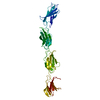
| ||||||||
|---|---|---|---|---|---|---|---|---|---|
| 1 |
| ||||||||
| Unit cell |
|
- Components
Components
| #1: Protein | Mass: 39981.160 Da / Num. of mol.: 1 Source method: isolated from a genetically manipulated source Source: (gene. exp.)  Homo sapiens (human) / Description: T7 EXPRESSION SYSTEM OF W. STUDIER / Cell line: BL21 / Plasmid: PET11B / Production host: Homo sapiens (human) / Description: T7 EXPRESSION SYSTEM OF W. STUDIER / Cell line: BL21 / Plasmid: PET11B / Production host:  |
|---|---|
| #2: Water | ChemComp-HOH / |
-Experimental details
-Experiment
| Experiment | Method:  X-RAY DIFFRACTION / Number of used crystals: 1 X-RAY DIFFRACTION / Number of used crystals: 1 |
|---|
- Sample preparation
Sample preparation
| Crystal | Density Matthews: 2.76 Å3/Da / Density % sol: 55.51 % | ||||||||||||||||||||||||||||||
|---|---|---|---|---|---|---|---|---|---|---|---|---|---|---|---|---|---|---|---|---|---|---|---|---|---|---|---|---|---|---|---|
| Crystal grow | pH: 5.8 / Details: pH 5.8 | ||||||||||||||||||||||||||||||
| Crystal grow | *PLUS Method: vapor diffusion, hanging drop | ||||||||||||||||||||||||||||||
| Components of the solutions | *PLUS
|
-Data collection
| Diffraction | Mean temperature: 100 K | |||||||||||||||
|---|---|---|---|---|---|---|---|---|---|---|---|---|---|---|---|---|
| Diffraction source | Source:  SYNCHROTRON / Site: SYNCHROTRON / Site:  NSLS NSLS  / Beamline: X4A / Wavelength: 0.9871, 0.9793, 0.9790, 0.9686 / Beamline: X4A / Wavelength: 0.9871, 0.9793, 0.9790, 0.9686 | |||||||||||||||
| Detector | Type: FUJI / Detector: IMAGE PLATE / Date: Oct 1, 1994 | |||||||||||||||
| Radiation | Monochromatic (M) / Laue (L): M / Scattering type: x-ray | |||||||||||||||
| Radiation wavelength |
| |||||||||||||||
| Reflection | Resolution: 2→30 Å / Num. obs: 28425 / % possible obs: 95.3 % / Rmerge(I) obs: 0.043 | |||||||||||||||
| Reflection | *PLUS Rmerge(I) obs: 0.043 |
- Processing
Processing
| Software |
| ||||||||||||||||||||||||||||||||||||||||||||||||||||||||||||
|---|---|---|---|---|---|---|---|---|---|---|---|---|---|---|---|---|---|---|---|---|---|---|---|---|---|---|---|---|---|---|---|---|---|---|---|---|---|---|---|---|---|---|---|---|---|---|---|---|---|---|---|---|---|---|---|---|---|---|---|---|---|
| Refinement | Resolution: 2→6 Å / σ(F): 2
| ||||||||||||||||||||||||||||||||||||||||||||||||||||||||||||
| Displacement parameters | Biso mean: 37.7 Å2 | ||||||||||||||||||||||||||||||||||||||||||||||||||||||||||||
| Refinement step | Cycle: LAST / Resolution: 2→6 Å
| ||||||||||||||||||||||||||||||||||||||||||||||||||||||||||||
| Refine LS restraints |
| ||||||||||||||||||||||||||||||||||||||||||||||||||||||||||||
| Software | *PLUS Name:  X-PLOR / Classification: refinement X-PLOR / Classification: refinement | ||||||||||||||||||||||||||||||||||||||||||||||||||||||||||||
| Refinement | *PLUS Rfactor all: 0.235 | ||||||||||||||||||||||||||||||||||||||||||||||||||||||||||||
| Solvent computation | *PLUS | ||||||||||||||||||||||||||||||||||||||||||||||||||||||||||||
| Displacement parameters | *PLUS | ||||||||||||||||||||||||||||||||||||||||||||||||||||||||||||
| Refine LS restraints | *PLUS
|
 Movie
Movie Controller
Controller



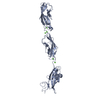
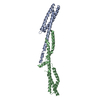

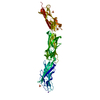


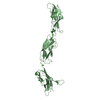


 PDBj
PDBj











